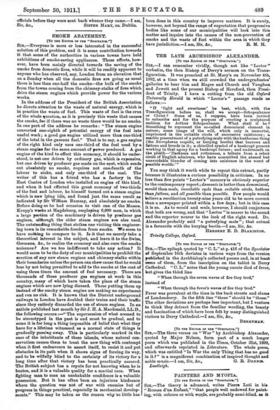PAINTERS AND M
[To THE EDITOR OF THE "SPECTATOR."] Sr.n,—The theory is advanced, writes Pierre Loti in his " Roman d'un Enfant," "that people well endowed for paint- ing, with colours or with, words, are probably semi-blind. as it were, living habitually in a kind of penumbra, in a lunar fog, their look turned inward, and therefore impressed, when by chance they see anything, ten times more keenly than are other men." A bit paradoxical this theory seems to him. " Yet it is certain that the penumbra conduces to our seeing better—as, for example, in panoramas, the obscurity of the vestibule prepares so well the final illusion "—le grand tromps. l'a:il final.
Loti's " theorician" was, perhaps, P. G. Hamerton, for Mr. Hamerton, in his book on " Landscape," asserts that "the possession of very good eyesight may be a hindrance to those feelings of sublimity that exalt the poetic imagination." Of all possible writers it is, by good luck, Lafcadio Hearn who, in a newspaper article published in New Orleans, points out that the impressiveness of natural scenery partly depends on the predominance of mass over detail. And since the per- ception of details depends vastly upon the quality of eye- sight, a landscape necessarily suggests less to a keen-sighted man than to the myope." Has not Andrew Lang written of the wicked fairy at a christening who said :—
"I shall be avenged on you,
My child, you shall grow up nearsighted !"
.--which endowment proved to be the best gift of all, since
" Where you see patchy fields and fences, For me, the mists of Turner swim—
My ' azure distance' soon commences !"
—and so forth ?
Hearn, to be sure, was—and that both physically and artis- tically—such an one as Mr. Lang so whimsically represents. In his early work, one is conscious of a kind of colour-intoxica- tion on the part of this master of style. In his " Two Years in the French West Indies," Hearn is hardly out of New York harbour before "the water takes on another hue : pale green lights play through it. It has begun to sound. Little waves lift up their heads as if to look at us, patting the flanks of the vessel, and whispering to one another." When the sun sets the vision is indeed amazing :—
" Crimsoning more and more, the sun drops to the sea. The phantom ship approaches him—touches the curve of his glowing face, sails right athwart it ! Oh ! the spectral splendour of that vision! The whole great ship in full sail makes an acute silhouette against the monstrous disc—rests there in the very middle of the vermilion sun. His face crimsons high above her top-masts—broadens far beyond helm and bow-sprit. Against this weird magnificence her whole shape changes colour : hull, masts, and sails turn black—a greenish black."
Were I concerned, for the moment, with Hearn's develop- ment as a writer, I should insist upon the fact that his book on the "French West Indies" was atransitional work (anEnglish critic, sympathetic otherwise, refers to it as of the " cockatoo and orchid " variety); I should say that his later books were in better taste, and marked with more and more of reserve and of delicacy. The present question is, however, only that of nearsightedness and painting—" with colours or words."
And that, even, is baffling beyond resolution. One cannot generalize very far where genius is in point. Hearn himself noted that though Gautier, among the French romantics, was a "myope," Hugo's eye was as clear as a bird's. Not the lens alone, but the finder, counts in literary photography.—I am,











































 Previous page
Previous page